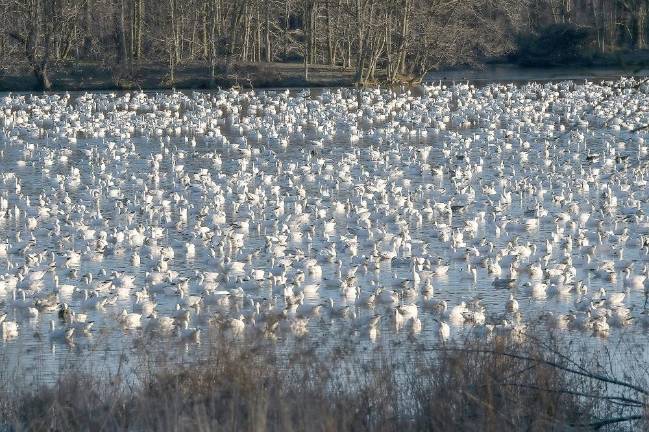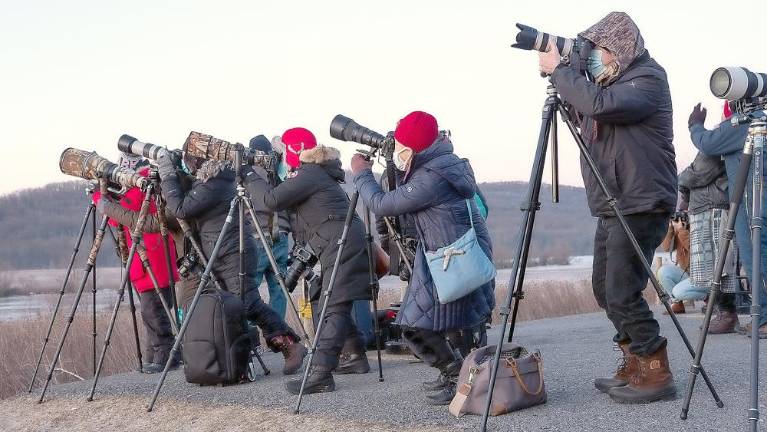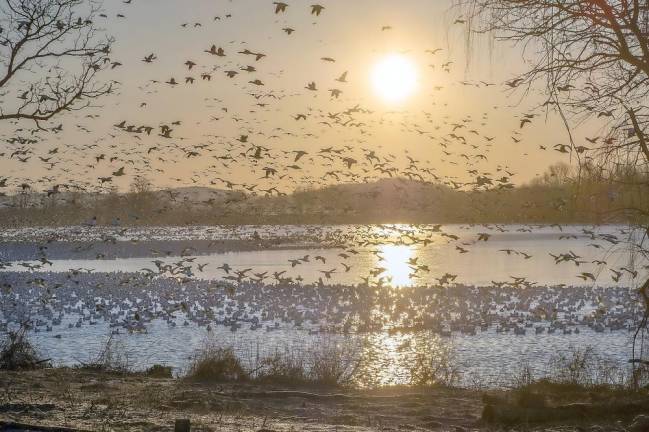A ‘blizzard’ of snow geese at Pennsylvania’s Middle Creek
Wildlife. The annual spring mass migration of the handsome white birds has made Middle Creek, managed by the Pennsylvania Game Commission, a worldwide destination for nature lovers and shutterbugs.



No one saw it coming.
When Pennsylvania built a 6,400-acre waterfowl haven on farmland in a southeastern nook of the state in the early 1970s, the goal was to bolster then-struggling Canada geese populations and give hunters from the populous eastern part of the state a crack at topnotch waterfowl shooting.
Today, though, Middle Creek Wildlife Management Area attracts many more photographers and tourists than hunters. The object of their affection: as many as 150,000 snow geese amassing on any given day over a month or so in February and March. They are on a 3,000-mile migration from wintering grounds in the Chesapeake Bay region back to their Arctic breeding grounds. Joining them at the stopover are smaller numbers of tundra swans and Canada geese.
The “blizzard of white,” as local residents affectionately call it, gives the illusion that the fields and 400-acre lake are covered in snow. When the birds take off in unison in large waves, the noise of their excited honks and wings chopping water can seem deafening. A collective takeoff is truly one of nature’s stirring sights. A recent witness described it as “like stepping out into the pages of National Geographic.” The outburst is invariably followed by dead silence.
The annual spring mass migration of the handsome white birds has made Middle Creek, managed by the Pennsylvania Game Commission, a worldwide destination for nature lovers and shutterbugs.
In recent years, the migration has attracted large numbers of international visitors, especially from China and other Asian countries. At one point, informational signs at Middle Creek were printed in Mandarin, as well as English, Spanish and German.
Spiritual seekers
Many are keen on photography but there are spiritual draws, too, explained Zhen Li from State College, Pa. Like 200 others, she had arrived at Middle Creek at 6 a.m. on a Monday in early March, with temperatures in the low 20s, to view the liftoffs.
“They mate for life. The fidelity and loyalty is really inspiring,” said Li, adding that the white birds on blue water made it seem like a cloud had fallen to earth.
Among the others gathered expectantly in the pre-dawn of that morning were four young Amish schoolteachers who wanted to witness what they called “God’s creation” and be back at their small school by 8 a.m.
A retired couple from Pennsylvania had driven an hour to see the raucous scene for the second time. “It’s such a beautiful thing to see so many snow geese and tundra swans in one place,” Vicki Brickner said. “And when they start to burst, you can’t even put it into words. It’s that amazing.”
On this morning, parents had rousted their children out of bed and bundled them in blankets. Some sat in chairs, wearing earmuffs, waiting for the the big event. A couple stood with camera tripods on top of a picnic table. A man hunched over a long camera lens had come from Alabama after being told on a bird photography trip in Tennessee that the snow goose scene at Middle Creek is a must-see.
Many visitors seek to witness a sunrise explosion of snow geese. But afternoons are popular, too, when skeins of geese, sunlight illuminating their bodies like globes, fly back to the lake in huge flocks after feeding in area fields.
Hunting allowed
Middle Creek, nestled in a valley of farmland in Lancaster and Lebanon counties, is called a management area, not a refuge, because snow geese, Canada geese and ducks are hunted from controlled blinds before the migration starts.
But because state taxpayer money helped to create the site, public recreation was also part of the plan. The lake is used for fishing and paddling, and miles of trails go through both forests and fields of the area and surrounding state game lands. A visitor center offers incredible views and exhibits on area waterfowl and wildlife.
The area’s diverse habitat makes it a magnet for birders seeking a wide variety of species. The lake has supported pairs of nesting eagles for years. Approximately 33 species of ducks have been sighted, as well as shorebirds. A great blue heron rookery, meadowlarks, bobolinks, short-eared owls and northern harriers are also among the potential sightings.
To provide waterfowl with all that they need for an important rest on their epic migration, land managers constructed the lake as well as shallow ponds and wetlands. Former farm fields were planted with millet, corn and other food that waterfowl forage.
It has worked. Middle Creek opened in 1972 and the numbers of waterfowl stopping by have been increasing ever since.
Tundra swans first appeared on their spring migration in 1976 with about a dozen showing up. Now, you may see about 15,000 in good years and 5,000 in less dynamic years.
The arrival of snow geese started slowly, with only a couple hundred to 1,500 from the late 1970s into the mid-1990s. Then their numbers exploded. Approximately 50,000 were counted in 1995 and 100,000 the next year.
Now, you can expect about 250,000 snow geese to visit Middle Creek from late January into mid-March, when the last stragglers wing north again. The single-day record is 200,000 on Feb. 21, 2018.
Hints of trouble
Middle Creek has become a vital stop in the migration of waterfowl in the Atlantic Flyway — a major north-south aerial route for migratory birds in North America. Snow geese may have traveled 800 miles before touching down. It’s believed that a large percentage of eastern North America’s tundra swan population uses Middle Creek as a migratory rest stop.
In 2010, Middle Creek was named a Globally Significant Important Bird Area by the National Audubon Society.
As beautiful a sight as it is, seeing so many snow geese at one location also hints at trouble elsewhere: Snow geese had a population boom in the 1980s and 1990s, at one point doubling in size every eight years, and their exploding numbers threatened to denude historic Arctic breeding grounds.
One of the main reasons for the surge was that geese adjusted their migratory flight patterns to feed in farm fields. Also, warming winter temperatures caused fewer die-offs. That means healthier birds are reaching breeding grounds and producing more young.
In 1998, snow geese were declared overabundant by game managers in the U.S. and Canada. Since then, liberalized hunting seasons and bag limits have stabilized populations. But the shots that ring from surrounding lands at Middle Creek during snow goose watches often startle and confuse the visitors.
Still, as snow geese find equilibrium with the world around them, their spectacular convergence at Middle Creek is an annual marvel of sight and sound.
Editor’s note: Ad Crable is a Bay Journal staff writer based in Pennsylvania. This article was originally published in the January/February 2022 edition of the Bay Journal and was distributed by the Bay Journal News Service.